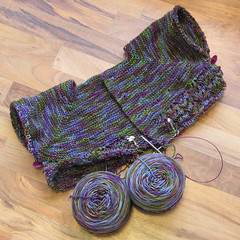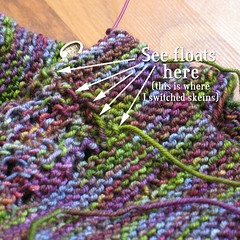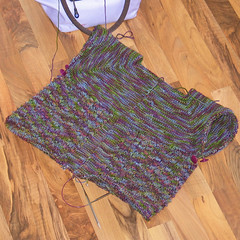Works in progress are so much fun. I found I have all sorts of great pictures, but have been too much of a slacker to blog them. So, here they are, a bit late and after the fact, but happily put together so you, kind reader, can see what I've been frantically knitting over the past couple of weeks!
My friend Andrea lit a fire under me (figuratively and I'm sure unintentionally) by making more progress than I did on her gorgeous FLS over the course of last week. I decided I was going to catch up, although probably not surpass her. I was hoping we'd both be able to wear our sweaters next Monday and get a paired picture. Wouldn't that be fun? So I set to knitting with a vengeance, and bumped up my goal of one lace repeat per day, to two repeats.
One of the things I found really interesting was the variations in color between skeins. I assumed that BMFA did they're dying in larger lots, but what most of us in this KAL have found out (because we were kind enough to share the information around) is that BMFA generally dyes two skeins at a time. That means with a three-skein project, you're sure to get one that was dyed a bit differently. In some projects, this has been painfully obvious. I opted to start striping back and forth between two skeins once I got to the lace portion of my FLS. It's a bit more work (okay, it's a LOT more work) but in the end the outcome is worth it. Pooling is much reduced and so is the obvious "argyle" pattern you can get from shaded yarns.
Because this is a cardigan knit in one piece, I didn't want to switch my skeins at the edge of my work. This would make for some obvious "floating" bits of yarn every time I switched skeins, right on the front edge of the sweater. Instead, I opted to switch at the edge of the garter-stitch border, right where it transitioned into lace. I started by twisting the two skeins together, but this didn't provide a strong enough link between the two skeins. Instead, I ended up knitting the first stitch after the switch with both strands held together. Because it was a transition from garter to lace, you can't even see the slightly thicker part where every-other-row there is one stitch held doubled. It made the join even and almost un-detectable. In fact, I dare anyone to find it without a magnifying glass.
I also did this again on the sleeves at the beginning of each round. There's a little jog there anyway, so it hides the irregularity of the stitch-weight. I'm really happy with how the sweater is turning out! It has beautiful colors that will look lovely with my wardrobe, and I have high hopes to finish in time to wear it for Easter.




No comments:
Post a Comment